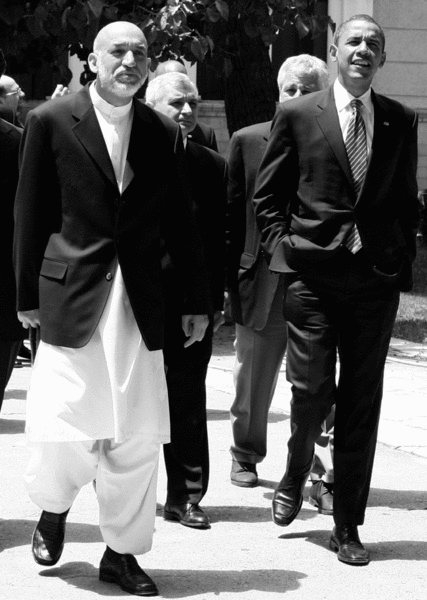
The sudden destruction of the World Trade Center and devastating attack on the Pentagon that claimed thousands of lives on September 11, 2001, traumatically revealed to a complacent America the existence of a radical Islamist terrorist threat based in South-Central Asia, potent enough to breach the country’s historic “ocean walls” of defense. A challenge like no other—the idea that violent attacks could seemingly drop at will from the skies—hung suspended over US foreign policy debates like the sword of Damocles. Amidst national fear and mourning tempered by world sympathy and support, eradication of this threat was held to be as sacred an obligation and existential imperative as defeating fascism was after the attacks on Pearl Harbor. America would “pay any price, bear any burden,” President Bush declared, in the struggle to bring the perpetrator, Osama bin Laden, to justice. This included denying sanctuary to future terrorists by overthrowing the Taliban regime that had sheltered him and his Al Qaeda followers in Afghanistan, and materially and ideologically combating Muslim fundamentalism worldwide. “This generation,” one commentator solemnly pronounced, “will be judged by how it responded to 9/11.”
That was a long time ago, in the way things are measured in unsettled and complicated ages. And long before George Bush handed over the burden of national security to President Barack Obama, successive crises ranging from the geopolitical to the financial had far superseded Afghanistan and its region as the onetime “challenge of a generation” in the minds of a deeply insecure American public. Yet more than seven years later, the original challenge of those dark days remains suspended, and many believe that it is still there because the response was suspended as well.
President Obama has made awareness of these crises and the need for confidence in dealing with them the opening theme of his administration. “Only a handful of times in our history has a generation been confronted with challenges so vast,” he declared to the throng that gathered at Philadelphia’s 30th Street Station as he journeyed toward Washington three days before he was inaugurated. Referring to the nation’s ongoing wars in Iraq and Afghanistan, he characterized the first as “one that needs to be ended responsibly,” and the second as one that needs to be “waged wisely.”
The new president’s choice of words carried with it the implication that the initial “challenge of a generation” had not been met in an effective way. Amidst a critical deterioration of the security situation in Afghanistan centered on but not limited to a powerful resurgence of the Taliban, this seems self-evident. What had happened to a task that for a brief but intensely emotional time seemed to be the number one priority of the United Sates of America?
ABANDONING THE HUNT FOR OSAMA
The speed and ease with which the Taliban were overthrown created an artificial sense of accomplishment among Americans—a feeling that the great challenge had been dealt with. “Everything But Osama,” a New York Times headline declared in December 2001. The Bonn Conference convened that month to settle Afghanistan’s future, named a new government headed by Hamid Karzai, and vowed that the international community would guarantee the country’s “security and reconstruction.” With the mission supposedly accomplished, the world breathed a brief sigh of relief before turning its attention to Iraq. This left the man who had planned and provoked the horrific attacks of historical proportions free to escape, along with his Al Qaeda followers and Taliban allies, into Pakistan’s Tribal Areas. Pakistan’s military establishment—which had helped create the Taliban and powerfully supported their drive to power before claiming to have become allies against them under the pressure of an ultimatum from Washington—assured the world that they would do everything to help track him down. Amidst the euphoria of “victory,” the role that Pakistan’s military had long played in fostering Islamic militancy in the region was ignored, and its suitability as an ally would come back to haunt US anti-terrorism efforts.
With Afghanistan “settled,” the Bush administration launched its highly divisive war in Iraq, claiming that it was a continuation of America’s response to 9/11. The far greater intensity of that conflict, in terms of troops committed, resistance offered, money spent, lives lost, and ultimate public disapproval of the war soon relegated Afghanistan to yesterday’s news. When news from Afghanistan was aired, it was in terms of the progress being made in holding democratic presidential and parliamentary elections, the slow pace of reconstruction, the uncertain development of women’s rights, a corrosive narcotics trade and attendant corruption, and rumblings of a Taliban comeback. Hardly enough to hold the attention of an American nation preoccupied with Iraq, Hurricane Katrina, spasms of the Arab-Israeli conflict, the Asian tsunami, global warming, and most recently, a financial meltdown of international scope accompanied by attendant scandals, the proportions of which are so vast that economists predict the world financial landscape and America’s position within it will be forever altered.
Yet this neglect of the “challenge of a generation”—or rather, this constant redefining of what that challenge is—has come at a price. While it is true that there has been an absence of any new terror-driven attacks in the US since 9/11, as the Obama administration takes office amidst these myriad crises, the situation in Afghanistan is the worse it has ever been since 2001. The Taliban resurgence has reached the point where they easily operate in three-quarters of the country, halting what little reconstruction was going on in many of those areas and stifling any newly established economic life as well. Karzai’s government has largely lost the confidence of the Afghan population, is condemned for being unable to deliver on security or reconstruction, and is widely viewed as being corrupt and linked to narcotraffickers. The international military forces led by the United States are not only derided for being unable to control the rising violence, but resented for having contributed to the death toll with repeated deadly airstrikes that have killed hundreds of civilians. And all the while, the prime driver of the suspended challenge, Osama bin Laden, continues in his elusiveness, maintaining silence or issuing new calls for jihad, as he sees fit.
President Obama, who opposed the war in Iraq, has called Afghanistan “the central front in the war on terror,” a fight “which never should have been abandoned,” and has vowed to pull the country and the international mission there out of its downward spiral. To address the immediate, critical question of deteriorating security, he has resolved to send in up to 30,000 more American troops, doubling the American military presence there. The introduction of the troops is already the focus of heavy criticism in both Congress and the press, and the strategy they will implement remains nebulous.
THE GREAT BLACK HOPE
Against this backdrop, many in the international relations community have begun to wonder if the situation in Afghanistan is even salvageable at this late date. While the incoming Obama administration brings with it an aura of hope—almost unrealistically so—to a world impatient with the “no negotiation with terrorists” dogma of the unpopular Bush administration (despite its admitted success in preventing further attacks upon American soil), questions arise: Does the Obama team indeed have a comprehensive strategy for turning things around that goes beyond the introduction of more firepower? What should that strategy be, and how much of it should depend on dealing with the south-central Asian region as a whole? With eight years now passed since 9/11, is Afghanistan still a matter of vital concern to America and the West? And even if it is, can Obama succeed in rallying support for continued American involvement there when the war-weary public has other matters on its mind?
Indispensible to answering these questions is a critical look at what went wrong in the first place, captured in the work of Ahmed Rashid, a Pakistani journalist whose books Taliban and Descent into Chaos are some of the most widely read accounts of the country and its region. “The Bush administration never had a comprehensive strategy for stabilizing Afghanistan beyond capturing Al Qaeda militants,” Rashid said. “The Taliban resurgence was ignored for too long, the safe havens for the Taliban leadership in the Tribal Areas and the city of Quetta in Pakistan were not properly addressed, and there was too much mollycoddling of General Musharraf, the Pakistani military ruler at the time. There was a lack of a common regional strategy. Also ignored was the rebuilding of the infrastructure to allow the Afghan economy to stand on its own two feet, economic development, and a regional agreement involving all of Afghanistan’s neighbors to stabilize the country. As a result, today the Taliban, al Qaeda, and their allies such as the Kashmiri militant groups present a dire threat to the United States, Europe, and, of course, South and Central Asia directly, as seen recently by the massacre in Mumbai.”
Indeed, Bush’s determination to invade Iraq is usually cited as the main reason for the neglect of the Afghan front. Yet, even devoting attention, effort, blood, and treasure does not guarantee success, especially in the absence of a viable plan that addresses the critical issues: What Afghanistan is, how it got to the point where it became a haven for terrorists, and its basic viability as a state.
WHAT IS AFGHANISTAN?
Founded in the 18th century as an empire forged by the Pashtun ethnic group through their conquest of neighboring ethnicities, Afghanistan’s geopolitics have always involved the dual dynamic of maintaining internal cohesion while staving off outside bids to conquer it. The first part has usually been accomplished without major turbulence by co-opting the Tajik, Uzbek, Hazara, and other ethnic groups into the Pashtun-dominated state by a carrot-and-stick policy. Rewards for loyalty were combined with light governance, alternating with a use of force against rebels when necessary. This method’s historic success belies the cliché that the country is “ungovernable,” and experts such as Rashid have stated that some form of federalism combined with solid army and police forces is key to a peaceful Afghanistan in the present circumstances. Dealing with predatory neighbors is a more difficult problem.
The Afghan empire itself fell victim to aggression in the early 19th century when the southeastern half of its core Pashtun lands was conquered by the Sikh empire. These lands were later annexed by British India and ultimately handed over to its successor state in the region, Pakistan, never reverting to Afghan sovereignty. This geopolitical division of the Pashtun is central to the current situation, for it is a major reason that the Pashtun-dominated Taliban are able to seek haven amidst one branch of their prime constituency and launch attacks into Afghanistan—while offering nanawati (“sanctuary”) to Osama bin Laden. Subsequent attempts by Great Britain in the 19th century and the Soviet Union in the 1980s to conquer the rest of the country came to grief, giving rise to the related cliché that it is also “unconquerable.” Successful subversion, however, is another matter.
It was Soviet infiltration of the Afghan army that enabled them to launch a coup that brought Communists to power in Kabul in 1978, but the populace’s revolt against the regime brought on the disastrous Russian invasion. Ever seeking an edge in the Cold War, the United States materially supported the Afghan mujahideen resistance fighters in alliance with Pakistan, their whole operation based in the Tribal Areas. Pakistan’s military rulers, however, had their own agenda. Having long used violent Islamic sentiment to forestall political and social change at home and confront India over the disputed state of Kashmir, they hoped to install a fundamentalist proxy regime in Kabul in order to gain what they called “strategic depth” in that struggle once the Soviets left and America lost interest in the region. Though both superpowers eventually cooperated in this way, Afghan resistance was more problematic. It was only after a decade of destructive civil war and warlord rivalry that the Pakistanis were finally able to put their Taliban candidates for the Afghan throne into power in the late 1990s—an achievement that was reversed by America’s initial response to 9/11.
STABILIZING AFGHANISTAN
Any plan for stabilizing Afghanistan must take these complicated internal and regional dynamics into account. Whether these problems are intractable is the subject of much debate.
“My growing worry is that, as currently constituted, Afghanistan simply lacks the natural DNA for enduring, viable nation-statehood on its own,” said Whitney Azoy, a longtime expert on the country who was until recently the head of the American Institute for Afghan Studies in Kabul. “‘On its own’ is the key phrase here. Let’s remember how it came into being, as an exercise in Pashtun expansionism—but this effort would not have lasted without outside support from the powers who subsidized and ratified it as a buffer state: Great Britain and Czarist Russia in the 19th century, the US and the USSR in the 20th. When one of the guarantors decided that the buffer status no longer served its interests, chaos followed. In the current situation, the question is ‘Who will pay the bills and guarantee the state into an indefinite future?’ Certainly not Afghanistan, which has never done so.”
While not denying that this devastated land is in need of guarantors, Ahmed Rashid is more optimistic about the country’s internal prospects. “The emphasis should be on rebuilding the ‘minimalist state’ that existed for 200 years before the Soviet invasion,” Rashid said. “In this arrangement the Afghan government provided for internal conflict management and civil peace, while not posing a threat to any of its neighbors. These two basic aims should now include the rebuilding of the infrastructure—sufficient electric power, roads, water, investment in agriculture, and the rebuilding of minimalist state institutions—army, police, a justice system and bureaucracy to increase government capacity. The internal strategy should call for a ‘representative’ government, which is inclusive of all ethnic groups and factions rather than the Bush aim of trying to create a Western-style democracy. Economically, it is wrong to say, as some have, that Afghanistan produces nothing. It is a crossroads of trade for Central and South Asia and the Middle East, and it has large reserves of minerals, oil, and gas. But its infrastructure was never sufficiently developed by the Bush administration to get a minimal self-sustaining economy started up.”
As important as these enduring realities of Afghanistan are, they are greatly exacerbated by the severity of the situation at hand. Whatever ultimate plan the surge is meant to effect, the hard fact is that there are imposing obstacles to its tactical success, however wise newly elected President Obama’s ultimate strategy is.
DEFINING AFGHANISTAN’S “INSURGENCY”
The first is the considerable strength of the Afghan insurgency at this point. “Taliban” is too simplistic a term to describe it. Disappointment at the failings of the process initiated at Bonn and the traditional Afghan propensity to back political forces that seem to have the advantage in any given struggle has led many other groups and individuals to take up arms against the coalition consisting of the Afghan government and its international backers. They range from followers of veteran fundamentalist warlords of the anti-Soviet struggle—such as Gulbaddin Hekmatyar and Jalaluddin Haqqani—to narcotraffickers to unemployed men who are simply guns for hire.
More ominous is accumulating evidence that the Pakistani military establishment and its main intelligence gathering agency, the Inter-Services Intelligence (ISI), continues to support the Taliban and their allies. The hide-in-plain-sight existence of the Taliban leadership, including, apparently, its supreme commander, Mullah Omar, in the city of Quetta, has been cited for years as proof that Pakistan was not serious about this new alliance with the US, which only came about in the midst of world condemnation of its pro-Taliban stand and as the result of an American ultimatum. Numerous indications over the last several years that Pakistani agents were involved in supplying weaponry, logistical help, and even advance notice of coalition military actions obtained from the Americans themselves in intelligence briefings to the insurgents from the Tribal Areas added to these suspicions. Although whether this is a result of the central policies of the country’s military-security services complex itself or only the work of “rogue elements” has been disputed. The accusations reached a climax last July when American intelligence intercepted communications between known ISI agents and the Haqqani network, which proved that these Pakistani operatives had aided the later in their devastating suicide bombing of the Indian embassy in Kabul that killed 58 people last July.
Another pitfall is the growing the hostility of the Afghan population at large towards the coalition due to civilian deaths stemming from airstrikes and other military actions, reports of human rights abuses inflicted on detainees, and failed economic promises. This negativity is not limited to rural traditionalists or committed fundamentalists, but can be found even among the most progressive segments of society. “Over 85 percent of Afghans are living below the poverty line and don’t have enough to eat,” said Malalai Joya, a former member of the Afghan parliament who won international notice for her strong stands on women’s rights and blunt denunciations of warlord abuses that eventually led to her expulsion from the legislative body. Addressing the view of international forces in terms of equivalence with her traditional foes, she continued, “While the US military spends $65,000 a minute in Afghanistan for its operations, up to 18 million people out of a population of 26 million live on less than $2 a day. As soon as possible, the US and NATO troops must vacate our country. With the withdrawal of the occupation forces, we will have to face one enemy instead of two.”
THE DEBATE OVER OPTIONS
In the face of such an intractable situation, it has been said that the greatest obstacle facing the planned US surge of troops into Afghanistan and any ensuing foundation it is hoped the surge will lay toward stabilizing the country is the limited window of opportunity on hand. The perfect storm of Afghan impatience with the international presence, the weakness of the Karzai government, and the relentlessly rising violence of the insurgency may soon create a security vacuum so vast that the ensuing chaos would be blamed on America’s intervention after 9/11 by the native population. Only a policy that improves these conditions dramatically can restore a level of goodwill that will enable the coalition to pursue the goals the United States set out to achieve when it toppled the Taliban. In the broadest spectrum, the strategic options being discussed in government, the military, and among analysts are: 1) withdrawal, 2) comprehensive surge, and 3) containment.
A growing chorus of skeptics, the most vocal of whom are New York Times’ columnists Thomas Friedman and Bob Herbert, Professor Andrew Bacevich of Boston University, and Vermont’s Senator Bernie Sanders, has questioned the rationale behind the surge, calling it an “escalation without a plan,” and hinting that it could lead to a Vietnam-style quagmire. Although they do not form an organized lobby group and have different emphases in their criticisms, they raise concerns such as the possible destabilizing effect continued American military operations in Afghanistan could have on Pakistan, the historic resistance of Afghans to foreign occupiers, and the fact that Al Qaeda, the original target of the United States after 9/11, is now based in Pakistan. In an indication of just how much the conception of the “challenge of a generation” has shifted due to recent events at home, some of them have bluntly stated that money slated for use in a surge of troops not only would be better spent, but required, to deal with the financial crisis. At their most extreme, the arguments of these critics argue for a phased withdrawal of international troops from Afghanistan to match the one scheduled for Iraq. Such a demand is the focus of an organized campaign called Get Afghanistan Right, which is being led by Katrina vanden Heuvel of the left-wing magazine The Nation.
With diplomacy as the keynote of this school of thought, the line of thinking posits that the termination of a provocative American military presence can pave the way for a variety of multilateral negotiations among regional powers such as India, Pakistan, and even Iran to provide the sort of consensus that has allowed Afghanistan to live undisturbed in the past. The internal problems of the country would be dealt with by a combination of targeted economic aid and technical assistance to build civilian institutions.
Countering these objections, Ahmed Rashid said, “Critics have concentrated on the military surge, whereas what Obama plans to carry out is a more ‘comprehensive surge,’ which means more troops, but also a surge in plans for development, reconstruction, and setting out tougher objectives for the Afghan government to follow, such as the holding of free and fair elections in October, combating waste, corruption, lack of decision making, and an end to criticism of international forces by the Karzai government. Moreover, the US troop surge under General Petraeus will follow a new counterinsurgency strategy that will concentrate on securing populated areas and providing security so that development can take place, rather than a single-minded obsession of going after Al Qaeda. Obama cannot lay out an exit strategy as demanded, before even undertaking this outlined stabilization strategy, which has been entirely lacking for eight years.”
In this view, President Obama will be merely following the logic of his opposition to the Iraq war, and implementing the “security and reconstruction” paradigm laid down at the Bonn conference, which Bush failed to follow through on. But even Rashid feels that at this late date and with the situation so critical this approach is not sufficient, because it is centered primarily on internal conditions in Afghanistan. In his essay “From Great Game to Grand Bargain,” written with longtime Afghan specialist Professor Barnet Rubin of the Center on International Cooperation of New York University and published in the November/December 2008 issue of Foreign Affairs, Rashid argues that American strategy must also seek compromise with those insurgents who are willing to negotiate, and address regional rivalries and insecurities.
The key to any regional “grand bargain,” the authors state, is Pakistan. “Unless the decision-makers in Pakistan decide to make stabilizing the Afghan government a higher priority than countering the Indian threat, the insurgency conducted from bases in Pakistan will continue. Pakistan’s strategic goals in Afghanistan place Pakistan at odds not just with Afghanistan and India, and with US objectives in the region, but with the entire international community. Yet there is no multilateral framework for confronting this challenge.”
Pakistan can be brought on board as a guarantor of Afghan stability, they state, by assuring Pakistan “that the international community is committed to its territorial integrity,” greater international diplomatic efforts to resolve the dispute in Kashmir, and with economic incentives such as aid and actions to encourage trade between the country and America and Europe. Addressing the particular concerns of other regional players such as India, Iran, Russia, and China would be part of this “grand bargain” as well. Recognizing their proposal as “audacious,” the authors conclude by stating, “without such audacity, there is little hope for Afghanistan, for Pakistan, or for the region as a whole.”
One final line of thought, which is still a minority, views Pakistan as the source of the region’s troubles, an intractable force for instability and violence with which no bargain can be made. It concludes that the country’s continued support of the Taliban and lackluster performance against Al Qaeda, epitomized by its inability or unwillingness to capture or kill Osama bin Laden, are proof that it will never cooperate in stabilizing Afghanistan. This group sees a containment strategy similar to the one employed during the Cold War against the Soviet Union as the only approach that can stop Pakistan’s support for militant groups that attack Afghanistan and India. Openly labeling the country a state sponsor of terror, raising economic sanctions against it, and working with the Indian and Afghan militaries to counter the activities of such militants are the main points of this strategy.
“Afghanistan could survive into the foreseeable future as part of a regional security arrangement that, among other things, puts the screws to Pakistan,” said Whitney Azoy. “Such a security arrangement would have to be engineered by the US. The key would have to be a restoration of cooperative relations between America and Iran. With the US on tolerable terms with both India and Iran, Pakistan could be contained.”
Even a cursory look at the Afghan situation immediately brings on the realization that any thread taken up leads on to other parts of a complex labyrinth of issues, and that solving one challenge involves confronting another. There can be no clearer indication of this than Rashid’s, Rubin’s, and Azoy’s proposals to involve Iran in their quite different approaches to solving the seemingly intractable problems of Afghanistan and its region, since that country is involved in a host of other controversies, from its nuclear program to support for anti-Western militants in Iraq and Lebanon and Gaza. The clarity of 9/11 and its unitary challenge is a thing of the past, as use of the plural “challenges” by President Obama in his speeches shows all too well.
So long after that traumatically bracing day, Barack Obama’s greatest challenge regarding Afghanistan will be making the case to a stressed American public—primarily concerned with economic salvation—that Afghanistan is still their fight. Whatever course of action he chooses, Obama must combine swift, tangible successes on the ground with a mobilization of public opinion behind his policies in South-Central Asia in order to sustain the US presence there. And the ultimate measure of his success will be whether he can prevent a repetition of events that will have everyone declaring once again that Afghanistan is the “challenge of a generation.”
















